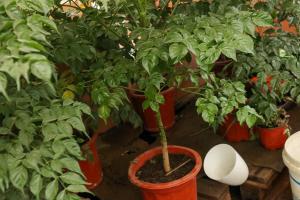What Causes Tomato Plant Leaves to Have Black Spots
Tomatoes are a popular and easy-to-grow crop for many home gardeners. However, like all plants, tomatoes can experience issues that may impact their growth and yield. One of the most common problems that tomato plants face is the appearance of black spots on their leaves. Below, we'll explore the various causes of black spots on tomato plant leaves.
Tomato Bacterial Spot
One of the most common perpetrators of black spots on tomato leaves is the bacteria Xanthomonas campestris, which causes what is known as Tomato Bacterial Spot. The bacteria can spread rapidly throughout a tomato plant and is typically passed through seed transmission, which means it can infect the plant before it is even planted. The bacteria thrives in warm and humid conditions, and once it infects a plant, it can cause lesions and black spots on the leaves, as well as the plant's fruit.
Tomato Late Blight
Another common reason for black spots on tomato plant leaves is the fungal disease known as Tomato Late Blight. Late blight can infect the leaves, stems, and fruit of a tomato plant, with characteristic black spots appearing on the plant's leaves. The fungus that causes Tomato Late Blight, Phytophthora infestans, thrives in cool and wet environments and can spread quickly from plant to plant. This disease often wreaks havoc on tomato crops and can cause significant damage.
Environmental Factors
Some black spots on tomato plant leaves may not be due to a disease at all but may instead be due to an environmental factor. For example, sunscald, caused by exposure to too much direct sunlight, can cause the leaves to turn black or brown in color. Poor water management can also contribute to black spots on tomato plant leaves, as excessive watering or drought stress can cause the leaves to die and turn black. Additionally, nutrient deficiencies in the soil or overfertilization can lead to black spots on tomato leaves.
Prevention and Treatment
Prevention is key when it comes to managing black spots on tomato plant leaves. Gardeners can take several measures to prevent the spread of diseases like Tomato Bacterial Spot and Tomato Late Blight, such as using certified disease-free seed, rotating crops, and practicing good garden sanitation, including the removal of diseased or infected plants. Similarly, environmental factors can be mitigated through proper watering and fertilization techniques and by providing shade for plants during the hottest parts of the day.
If a tomato plant does become infected with a disease that causes black spots on its leaves, treatment options may vary depending on the specific cause. The use of fungicides and bactericides may be effective, as well as the removal and destruction of infected plant parts. Additionally, some gardeners may choose to simply prune off the infected leaves, which can help to halt the spread of disease and promote new, healthy growth.
Conclusion
Black spots on tomato plant leaves can be caused by a variety of factors, including bacterial and fungal diseases as well as environmental factors. With proper prevention and treatment methods, gardeners can help to protect their plants from these issues and promote healthy growth and yield.

 how many times do yo...
how many times do yo... how many planted tre...
how many planted tre... how many pine trees ...
how many pine trees ... how many pecan trees...
how many pecan trees... how many plants comp...
how many plants comp... how many plants can ...
how many plants can ... how many plants and ...
how many plants and ... how many pepper plan...
how many pepper plan...































